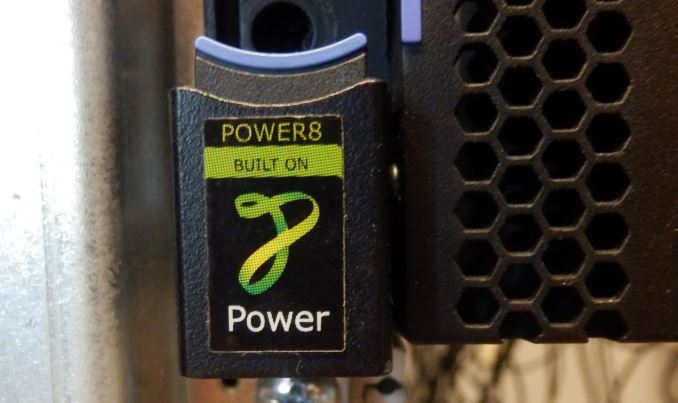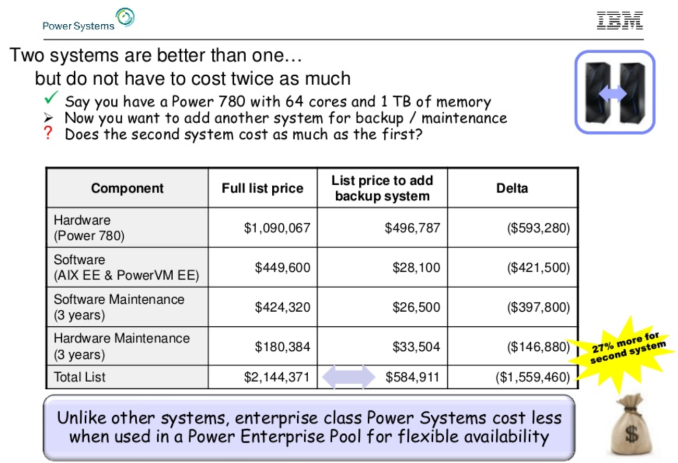The IBM POWER8 Review: Challenging the Intel Xeon
by Johan De Gelas on November 6, 2015 8:00 AM EST- Posted in
- IT Computing
- CPUs
- Enterprise
- Enterprise CPUs
- IBM
- POWER
- POWER8

Five years. That is how much time has passed since we have seen an affordable server processor that could keep up with or even beat Intel's best Xeons. These days no less than 95% of the server CPUs shipped are Intel Xeons. A few years ago, it looked like ARM servers were going to shake up the market this year, but to cut a long story short, it looks like the IBM POWER8 chip is probably the only viable alternative for the time being.
That was also noticeable in our Xeon E7 review, which was much more popular than we ever hoped. One of the reasons was the inclusion of a few IBM POWER8 benchmarks. We admit that the article was however incomplete: the POWER8 development machine we tested was a virtual machine with only 1 core, 8 threads and 2 GB of RAM, which is not enough to do any thorough server testing.
After seeing the reader interest in POWER8 in that previous article, we decided to investigate the matter further. To that end we met with Franz Bourlet, an enthusiastic technical sales engineer at IBM and he made sure we got access to an IBM S822L server. Thanks to Franz and the good people of Arrow Enterprise Computing Solutions, Arrow was able to lend us an IBM S822L server for our testing.
A Real Alternative?
Some of you may argue that the POWER based servers have been around for years now. But the slide below illustrates what we typically associated IBM's POWER range with:
Proudly, the IBM sales team states that you can save 1.5 million dollars after you have paid them 2 million dollars for your high-end 780 system. There is definitely a market for such hugely expensive and robust server systems as high end RISC machines are good for about 50,000 clients. But frankly for most of us, those systems are nothing more than an expensive curiosity.
Availability can be handled by software and most of us are looking/forced to reduce our capital expenses rather than increase them. We want fast, "reliable enough" servers at low costs that are easy to service. And that is exactly the reason why the single and dual sockets Xeon servers have been so popular the past decade. Can an IBM POWER server be a real alternative to the typical Xeon E5 server? The short but vague answer: a lot has changed in the past years and months. So yes, maybe.











146 Comments
View All Comments
FunBunny2 - Friday, November 6, 2015 - link
"The z10 processor was co-developed with and shares many design traits with the POWER6 processor, such as fabrication technology, logic design, execution unit, floating-point units, bus technology (GX bus) and pipeline design style, i.e., a high frequency, low latency, deep (14 stages in the z10), in-order pipeline." from the Wiki.Yes, the z continues the CISC ISA from the 360 (well, sort of) rather than hardware RISC, but as Intel (amongst others) has demonstrated, CISC ISA doesn't have to be in hardware. In fact, the 360/30 (lowest tier) was wholly emulated, as was admitted then. Today, we'd say "micro-instructions". All those billions of transistors could have been used to implement X86 in hardware, but Intel went with emulation, sorry micro-ops.
What matters is the underlying fab tech. That's not going anywhere.
FunBunny2 - Friday, November 6, 2015 - link
^^ should have gone to KevinG!!Kevin G - Saturday, November 7, 2015 - link
The GX bus in the mainframes was indeed shared by POWER chips as that enabled system level component sharing (think chipsets).However, attributes like the execution unit and the pipeline depth are different between the POWER6 and z10. At a bird's eye view, they do look similar but the implementation is genuinely different.
Other features like SMT were introduced with the POWER5 but only the most recent z13 chip has 2 way SMT. Features like out-of-order execution, SMT, SIMD were once considered too exotic to validate in the mainframe market that needed absolute certainty in its hardware states. However, recent zArch chips have implemented these features, sometimes decades after being introduced in POWER.
The other thing is that IBM has been attempting to get get more and more of the zArch instruction set to be executed by hardware and no microcode. Roughly 75% to 80% of instructions are handled by microcode (there is a bit of a range here as some are conditional to use microcode).
JohanAnandtech - Saturday, November 7, 2015 - link
I believe that benchmark uses about 8 threads and not very well either? Secondly, it is probably very well optimized for SSE/AVX. So you can imagine that the POWER8 will not be very good at it, unless we manually optimize it for Altivec/VSX. And that is beyond my skills :-)UrQuan3 - Monday, December 21, 2015 - link
I'm sure no one is still reading this as I'm posting over a month later, but...I tested handbrake/x264 on a bunch of cross-platform builds including Raspberry Pi 2. I found it would take 24 RPi2s to match a single i5-4670K. That was a gcc compiled handbrake on Raspbian vs the heavily optimized DL copy for Windows. Not too bad really. Also, x264 seems to scale fairly well with the number of cores. Still, POWER8 unoptimized would be interesting, though not a fair test.
BTW, I'd encourage you to use a more standard Linux version than 6-month experimental little-endian version of Ubuntu. The slides you show advertise support for Ubuntu 14.04 LTS, not 15.04. For something this new, you may need the latest, but that is often not the case.
stun - Friday, November 6, 2015 - link
@Johan You might want to fix "the platform" hyperlink at the bottom of page 4. It is invalid.JohanAnandtech - Friday, November 6, 2015 - link
Thanks and fixed.Ahkorishaan - Friday, November 6, 2015 - link
Couldn't read past the graphic on page 1. It's 2015 IBM, time to use a font that doesn't look like a toddler's handwriting.xype - Sunday, November 8, 2015 - link
To be fair, it seems that the slide is meant for management types… :PJtaylor1986 - Friday, November 6, 2015 - link
Using decimals instead of commas to denote thousands is jarring to your North American readers.